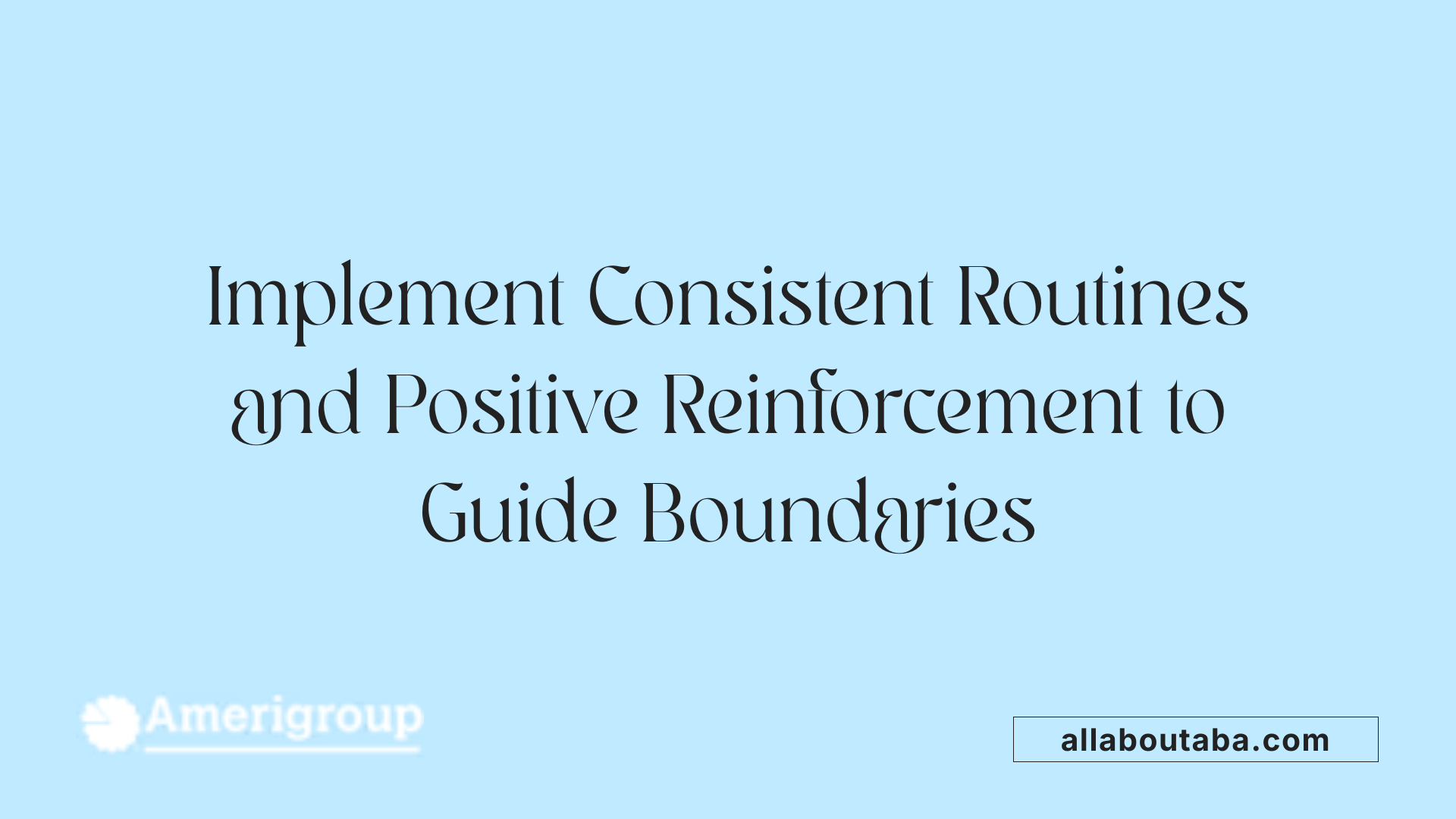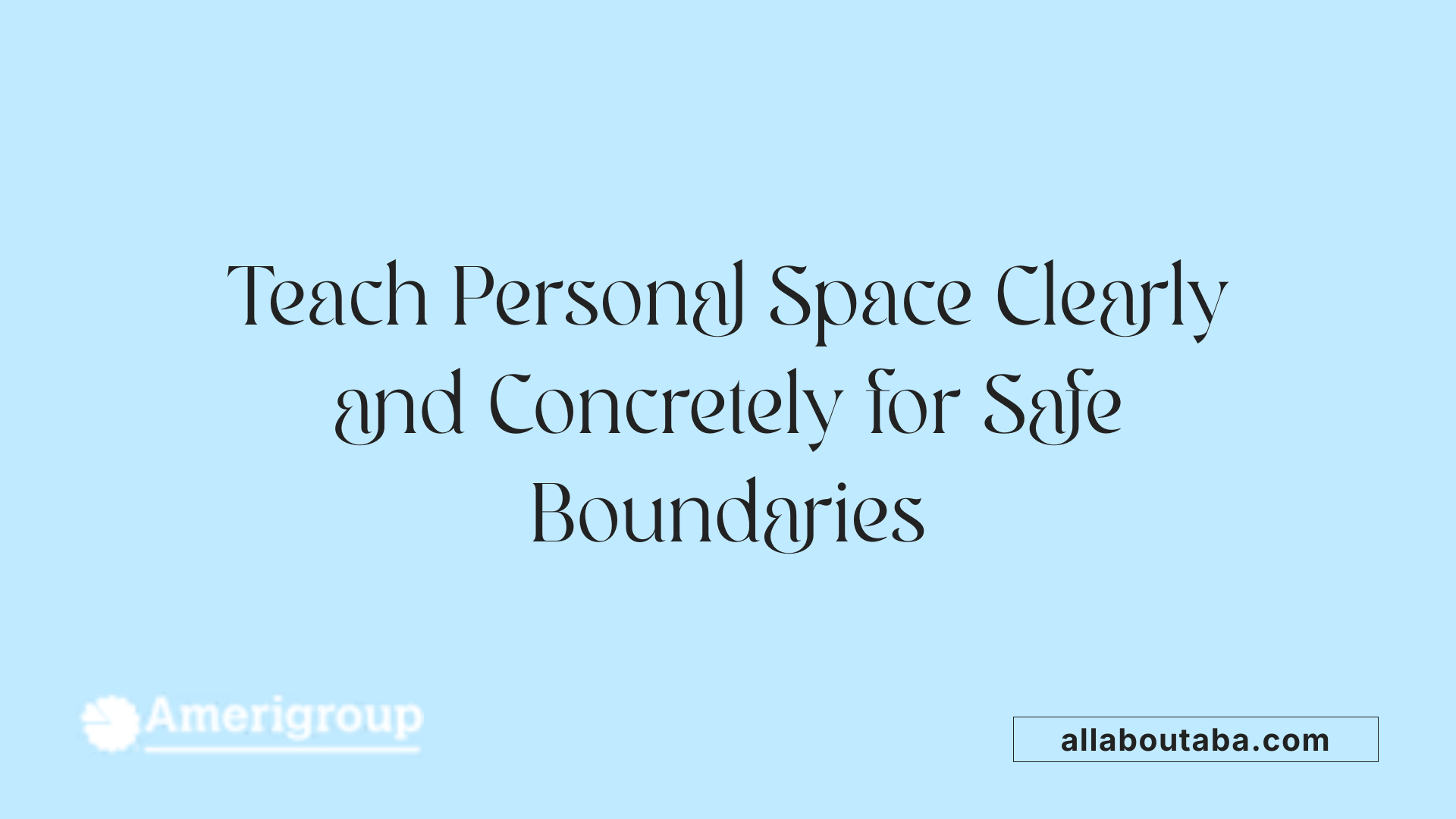How To Teach Social Boundaries To Autistic Children
Understanding the Foundation of Social Boundaries in Autism
Teaching social boundaries to autistic children is crucial for fostering safe, respectful interactions and promoting social development. Boundaries serve as unwritten rules that guide acceptable physical, emotional, and social behavior, helping children navigate their environment with confidence and understanding. This article explores effective methods, strategies, and tools that caregivers, teachers, and parents can employ to teach these boundaries thoroughly and compassionately, ensuring children develop essential social skills for healthy relationships.
Effective Methods for Teaching Social Boundaries

What are effective methods for teaching social boundaries to autistic children?
Teaching autistic children about social boundaries requires a combination of straightforward, visual, and interactive approaches. One of the most effective tools is the use of social stories. These are structured narratives that break down complex social concepts like personal space, appropriate behaviors, and body language into simple, easy-to-understand language. Social stories help children recognize social cues and understand what behaviors are expected in different scenarios, such as in public or private settings.
Visual supports further enhance understanding. Pictures, PECS (Picture Exchange Communication System) cards, and visual cues like diagrams and charts concretely illustrate concepts of personal space, acceptable touch, and body awareness. For instance, visual aids can depict different distances for personal space based on context, illustrating the difference between close friends and strangers.
Role-playing activities are another vital method. They allow children to rehearse real-life situations in a safe environment. Through role-play, children learn how to respond to social cues, recognize feelings in themselves and others, and practice saying ‘No thank you’ or other polite responses when faced with unwanted touch. These activities promote active learning and help children generalize skills across various settings.
Consistent routines are crucial. Using visual aids and established rules reinforces what is expected and helps reduce anxiety or confusion. For example, a visual schedule of daily routines can include specific steps for respecting personal space and recognizing boundaries.
Teaching about body parts, especially private versus public parts, is also fundamental. Explaining the differences and the importance of maintaining privacy, especially during activities like bath time, helps children understand their bodies and personal safety.
Strategies to discuss appropriate and inappropriate touch should be clear and direct. Using visual supports like pictures depicting safe and unsafe touches can help children grasp the concepts of personal safety and boundaries.
Caregivers play an essential role. Providing positive reinforcement, consistent feedback, and praise encourages children to practice respectful boundary behaviors. The use of reward systems, such as sticker charts or verbal praise, motivates children and helps solidify their understanding.
Regular feedback from caregivers and teachers enables children to understand what they’re doing well and where they can improve. Reinforcing boundary-respecting behaviors with genuine praise and gentle correction encourages ongoing learning.
Overall, combining these visual, interactive, and structured strategies creates a comprehensive approach. It supports autistic children in understanding and respecting social boundaries, leading to healthier social interactions and relationships.
Strategies and Discipline Techniques for Boundary Management

What are effective strategies and discipline techniques for teaching boundaries and managing behavior in autistic children?
Teaching boundaries to autistic children involves several practical approaches that support their understanding and acceptance of social norms and personal space.
One fundamental technique is the use of clear, consistent communication combined with visual supports. Visual aids such as social stories, pictures, PECS (Picture Exchange Communication Systems), and physical objects like hula hoops or big balls serve as tangible tools to reinforce the concept of personal space and appropriate behavior.
Structured routines are crucial for providing stability and predictability, making it easier for children to grasp boundaries. Incorporating visual schedules and timers helps children know what to expect and when transitions will happen. First/then statements are also effective, clearly detailing what happens first and following with what comes next, which guides behavior in a positive manner.
Positive reinforcement is a cornerstone of effective discipline. Praising children with specific, genuine words like "Great job staying in your space" or offering tangible rewards, such as stickers or token charts, reinforce desirable behaviors. Recognizing even small successes encourages children to continue practicing boundary-appropriate actions.
Creating designated calming and safe spaces within the home or classroom provides a retreat for children overwhelmed or overwhelmed by stimuli. These areas help children develop a sense of personal boundaries and learn to regulate their emotions.
Role-playing exercises, using visual aids, social stories, and modeling behaviors are excellent ways to teach children about boundaries actively. Through simulated social interactions, children can practice recognizing cues such as body language or facial expressions indicating comfort or discomfort.
Developing individualized behavior management plans is essential. These plans should include data collection on behaviors and triggers, allowing caregivers and educators to identify patterns and develop targeted interventions. Introducing replacement behaviors, like asking for a break or using words to express discomfort, can reduce problematic behaviors.
Consistency, patience, and ongoing collaboration with professionals such as speech therapists, occupational therapists, and behavioral specialists are important for effectively teaching boundaries. Regular monitoring and adjusting strategies based on the child's progress ensure that interventions remain relevant and effective.
Taking a holistic approach that combines these strategies can greatly improve an autistic child’s understanding of personal boundaries, promote healthy social interactions, and help reduce challenging behaviors.
| Strategy | Description | Additional Tips |
|---|---|---|
| Visual supports | Use pictures, social stories, and tangible objects | Reinforce with real-life practice |
| Structured routines | Use schedules and timers | Provide predictability |
| Positive reinforcement | Praise and tangible rewards | Be specific and consistent |
| Safe spaces | Designate calming areas | Tailor to child's needs |
| Role-playing | Practice social scenarios | Use modeling and prompts |
| Data collection & planning | Track behaviors & triggers | Adjust strategies as needed |
| Collaboration | Work with professionals | Ensure a team approach |
Mastering boundary teaching through these methods fosters a respectful understanding of social and personal space, helping children develop skills vital for successful social interactions and relationships.
Tools and Activities to Develop Social Boundary Skills

What are some tools and techniques for developing social boundary skills in autistic children?
Supporting autistic children in understanding and respecting personal boundaries requires a variety of targeted tools and activities. Visual aids are particularly effective, providing concrete representations of abstract social concepts. Common visual tools include floor markers, like hula hoops or carpet squares, which visually define personal space zones, and social stories that narrate scenarios involving boundaries, helping children understand appropriate behaviors.
In addition to visual aids, structured role-playing and social games offer safe environments for children to practice boundary-setting skills. For example, role-playing exercises can simulate social situations where children learn to recognize cues for personal space or appropriate touch. These activities can be enhanced with tangible objects such as beach balls or PECS (Picture Exchange Communication System) cards, which serve as physical prompts for boundary concepts.
Positive reinforcement is another cornerstone, encouraging children to demonstrate boundary-aware behaviors. Praising and rewarding children when they respect personal space or respond appropriately to social cues reinforce these behaviors and motivate ongoing practice.
Video modeling is an innovative technique that shows children watching peers or adults demonstrate boundary-appropriate actions, helping them internalize expected behaviors. Peer-mediated interventions involve trained peers guiding and reinforcing boundary-friendly interactions, fostering social learning in natural settings.
Routines incorporating visual supports, such as visual schedules and cues, consistently reinforce learning about boundaries. These supports help children anticipate and understand social rules, creating a predictable environment conducive to learning.
Self-monitoring and regulation strategies teach children to recognize their feelings and behaviors. Techniques such as using emotion charts or sensors guide them in self-assessment and adjusting their actions accordingly.
Patience and consistent practice by caregivers and educators are vital. Repetition and gentle correction build confidence and help embed boundary-respecting behaviors into daily routines.
In summary, combining visual aids, structured activities, positive reinforcement, video and peer interventions, routine use of visual supports, and self-regulation techniques provides a comprehensive approach. These strategies not only help children acquire essential social boundary skills but also foster a safe, supportive environment where they can thrive socially.
Establishing Personal Space and Boundaries

What approaches can be used to establish personal space and boundaries with autistic children?
Teaching autistic children about personal boundaries and space is a vital part of their social development. Several strategies can help make these concepts clear and manageable.
One effective method is the use of visual supports such as social stories, pictures, and tangible objects. Social stories are specially designed narratives that explain social situations and appropriate reactions, helping children understand what is expected of them. For example, a story might describe personal space by illustrating how close friends or family members can stand comfortably apart and what behaviors are appropriate in different settings.
Pictures and visual cues, like photographs or drawings, can depict correct distances and behaviors. Visual aids such as PECS (Picture Exchange Communication System) cards, or objects like hula hoops, carpet squares, or beach balls, serve as tangible tools to demonstrate personal space in a clear and concrete way.
In addition to visual supports, involving children in activities that teach body awareness is crucial. Incorporating lessons during everyday moments such as bath time or dressing routines helps normalize conversations about body parts, private and public areas. For example, explaining that certain body parts are private and should be covered in public contexts fosters safety awareness.
Teaching about 'good touch' and 'bad touch' is also fundamental. Using visual supports like pictures or stories demonstrates what kinds of contact are safe and appropriate versus those that are intrusive or harmful. This helps children recognize and verbalize discomfort, and use polite responses such as saying 'No thank you.' or physically signaling their boundaries through cues like high fives or stepping back.
Integrating activities like games, songs, and books makes learning about boundaries engaging and memorable. For example, singing songs about personal space, or playing games that involve respecting each other’s ‘bubble’ distance, reinforce these concepts.
Self-awareness and regulation are other important aspects. Teaching children to recognize their feelings and bodily cues through visual emotion charts can help them understand when they feel uncomfortable or overwhelmed.
Consistency and modeling behavior are essential. Caregivers and educators should consistently reinforce rules, demonstrate appropriate boundaries through their actions, and provide clear, explicit instructions.
Seeking professional guidance from specialists, including speech therapists and behavioral analysts, ensures that strategies are tailored to each child's needs and progress is monitored effectively.
Overall, a combination of visual supports, daily routines, engaging activities, and positive reinforcement builds a strong foundation for autistic children to understand and respect personal space and boundaries.
Supporting Social Development and Boundary Setting

How can parents and educators support social development and boundary setting in autistic children?
Supporting social development and boundary understanding in autistic children requires a combination of structured teaching, visual supports, and opportunities for practice. Parents and educators play an essential role by providing clear, explicit instructions through specialized social skills training programs such as Social Skills Training (SST). These programs often incorporate modeling behaviors, role-playing scenarios, and positive reinforcement to help children learn appropriate social responses.
Utilizing visual supports like social narratives, pictures, and visual scales helps children grasp social norms and expectations. Breaking down complex social skills into small, manageable steps makes learning more accessible and helps children successfully generalize skills across different settings. For example, teaching about personal boundaries, appropriate touch, and social cues through visual aids and stories makes the concepts concrete.
Encouraging interactions with peers through structured groups, guided activities, and paired play promotes social engagement. These activities often include turn-taking exercises, cooperative games, and role-playing to develop reciprocity and empathy.
Creating opportunities for children to practice social skills in a safe environment is crucial. Facilitated activities like social groups, where guided interactions occur under supervision, foster comfort and understanding of social boundaries.
Supporting emotional regulation is also vital. Sensory tools such as noise-canceling headphones, calming toys, or weighted blankets help children manage stress and emotions, enabling more meaningful social participation. Incorporating calming strategies and breaks helps prevent overwhelming situations.
Additionally, customizing interventions to match each child's unique strengths, interests, and motivations enhances the learning process. Recognizing and leveraging what excites or interests a child can motivate them to engage more in social activities.
By combining these strategies—structured training, visual supports, peer interactions, sensory tools, and individualized approaches—parents and educators can significantly support autistic children’s understanding of social boundaries and improve their overall social skills and relationships.
Fostering Respectful, Safe, and Understanding Environments
Teaching social boundaries to autistic children is a comprehensive process that involves clear communication, visual supports, role-playing, and positive reinforcement. By creating structured, predictable, and emotionally safe environments, caregivers and educators can help children understand their bodies, recognize social cues, and develop respectful interactions. Patience and consistency are fundamental, along with collaboration with professionals and involving children in rule-setting. Ultimately, these strategies support autistic children in building social confidence, forming meaningful relationships, and navigating the social world with greater competence and safety.
References
- Bodies & personal boundaries: autism
- Understanding Social Boundaries in Autism
- Teaching Autistic Children Personal Space And Boundaries
- Tools for Teaching Social Boundaries to Tweens and Teens
- Boundaries: Public, Private, Personal Space
- Taking the Sting out of Discipline for Autistic Kids
- Strategies for Teaching Boundaries Autism -
- Bodies & personal boundaries: autism
- Strategies for Teaching Boundaries Autism -
- Tools for Teaching Social Boundaries to Tweens and Teens
Other articles
Recent articles

The Role Of Teachers In Fostering Autism Peer Acceptance

Using Art Therapy To Support Children With Autism

Autism And Strategies For Addressing Sensory Defensiveness

Autism And The Benefits Of Structured Leisure Activities

How To Support Autistic Students During Exam Season

Autism And Goal Setting For Personal Growth

How To Use Gamification In Autism Learning Programs

How Schools Can Reduce Bullying Of Autistic Students

Early Intervention Strategies For Autism Spectrum Disorder

The Role Of Therapists In Autism Life Skills Coaching

How To Support Autistic Individuals In Crisis Situations

Autism And Self-Care Routines For Stress Management

Understanding Echolalia And Its Role In Autism Communication

Autism And Fine Arts Education Benefits

The Impact Of Multisensory Learning On Autism Education

How Family Counseling Supports Autism Household Dynamics

Best Practices For Inclusive Playgrounds For Autism

Best Practices For Autism-Friendly Shopping Centers

How Autism Affects Fine Motor Skill Development

Best Ways To Introduce Sensory Activities Into Daily Routines

How Sports Teams Can Be Inclusive Of Autistic Players

Autism And Strategies For Building Workplace Resilience

Autism And The Impact Of Hormonal Changes During Puberty

How To Support Autistic Students In Foreign Language Classes

Best Ways To Teach Money Skills To Teens With Autism

Supporting Siblings Of Children With Autism

Autism And Co-Occurring Gastrointestinal Disorders

The Role Of Art Projects In Autism Sensory Integration

How Schools Can Incorporate Sensory Break Spaces

Best Practices For Autism Sensory Regulation At School

Autism And Strategies For Teaching Organizational Skills

Understanding The Relationship Between Autism And Anxiety Disorders

Autism And Life Planning For Long-Term Care

Exploring Visual Supports In Autism Education

Ways To Encourage Social Interaction In Children With Autism

The Connection Between Autism And Dyscalculia

The Role Of Occupational Therapy In Transition Planning For Autism

The Role Of Physical Therapists In Autism Motor Skills Support

How To Teach Decision-Making Skills To Autistic Young Adults

The Connection Between Autism And Epilepsy

Best Practices For Transitioning Autistic Children Into New Schools

Autism And Time Management Challenges In Adulthood

The Role Of Visual Arts In Autism Communication Development

How To Address Tactile Defensiveness In Autism

Best Practices For Telehealth Autism Therapy

How To Help Autistic Children Develop Friendship Skills

How Schools Can Support Autistic Students In Career Prep

Best Strategies For Autism-Friendly Event Planning

Understanding Noncontingent Reinforcement In Autism Behavior Plans

How Drama Therapy Benefits Autistic Individuals

Best Practices For Autism-Friendly Fitness And Recreation Centers

Best Ways To Promote Healthy Social Media Use For Autistic Teens

How To Help Autistic Children Cope With Public Speaking

Autism And Strategies For Managing Unexpected Changes

Best Podcasts About Autism For Parents And Educators

Autism And The Impact Of Seasonal Changes On Behavior

The Role Of Diet In Managing Co-Occurring Conditions With Autism

Sleep Challenges In Autism And Practical Solutions

Best Ways To Build Daily Routines For Autistic Children

Best Practices For Supporting Autistic Entrepreneurs

Autism And Strategies For Navigating Large Social Gatherings

Adaptive Sports And Recreational Activities For People With Autism

Autism And The Benefits Of Story-Based Learning Activities

Understanding The Role Of Play In Autism Development

Autism And The Impact Of Environmental Noise On Learning

How To Create Autism-Friendly Community Spaces

Autism And Chronic Health Conditions: What To Know

The Role Of Care Managers In Autism Life Planning

How To Teach Social Boundaries To Autistic Children

How Autistic Individuals Experience Empathy Differently

How To Support Autistic Employees In Remote Work Settings

Autism And The Relationship Between Motor Skills And Learning

How To Create Community Resource Guides For Autism Families

How To Teach Daily Living Skills To Autistic Teens

Autism And The Impact Of Mind-Body Practices On Stress Reduction

Autism And The Benefits Of Outdoor Group Activities

How To Create Autism-Friendly Sensory Paths In Schools

Best Practices For Autism-Friendly Park And Recreation Areas

Autism And Strategies For Reducing School Refusal

Supporting Autistic Individuals In Public Speaking

The Role Of Diet In Managing Autism Symptoms

The Benefits Of Gardening Clubs For Autism Social Development

How To Prepare Autistic Children For Dental Visits

Autism And Employment: Career Paths That Work

Best Practices For Autism-Friendly Hotels And Lodging

The Impact Of Screen Time On Autism Development

Autism Screening Tools For Early Childhood

The Role Of Physical Exercise In Autism Therapy

Best Strategies For Supporting Autistic College Students

The Role Of Technology In Autism Early Detection

Sensory-Friendly Classroom Design Ideas For Autistic Students

The Role Of Speech Therapy In Building Social Communication Skills

Best Strategies For Handling Autistic Burnout In Adults

Autism And The Importance Of Predictability In Routine

Autism And Peer Education: Teaching Acceptance In Schools

Best Practices For Sensory-Friendly Libraries And Reading Rooms

Self-Advocacy Skills For Autistic Adults

The Role Of Technology In Autism Peer Communication

Promoting Physical Activity In Children With Autism

How To Prepare Autistic Children For Medical Procedures
We’re All About You, Your Family, and Your Child

